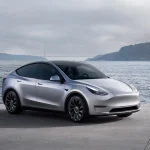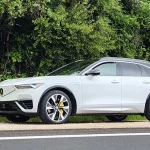
GM goal: profitable, affordable electric cars built in big numbersGM goal: profitable, affordable electric cars built in big numbers
Automotive innovation rolls out over many years, usually decades, and usually only a few companies lead.
Others hang back, waiting to see if buyers will accept new features, new powertrains, and new types of vehicles.
More than six years after modern electric cars hit the market in volume, many automakers are only now deciding on their strategies.
DON’T MISS: Has GM really ‘already lost’ the electric-car race to Tesla?
General Motors, however, is quite clear on its goal: it wants to be the first car company in the world to sell large numbers of electric cars profitably.
That’s the news delivered separately by GM CEO Mary Barra and its product chief Mark Reuss in recent weeks, according to The Detroit News.
Within the industry, it’s widely accepted that any new powertrain technology will likely take more than one model cycle to break even.
GM CEO Mary Barra and Chevy Bolt EV electric car image at 2016 Chevrolet Cruze launch, Jun 2015
Toyota is universally assumed to have lost money on every first-generation Prius hybrid it built from 1997 to 2003, and only started to turn a profit somewhere during that car’s second generation from 2004 to 2009.
Lower-than-planned sales of the Nissan Leaf over its seven-year life are widely assumed to have lost money for its maker.
And while Tesla Motors claims to turn a profit on its Model S and Model X luxury electric cars, those vehicles have not generated anywhere near the cash to invest in future products and expand its production.
Tesla has lost money continuously for more than 12 years, save for two marginally profitable quarters, sustained by injections of more than $2 billion in venture funding and stock sales.
“Our internal focus is to make GM the first maker of profitable, highly desirable, range-leading, and obtainable electric transportation,” CEO Barra said last month in the company’s first-quarter earnings call for investors, analysts, and media.
Reuss called the goal the “mantra” of product development, though he wouldn’t project when that could be achieved.
2011 Chevrolet Volt outside Detroit-Hamtramck assembly plant
GM’s ability to sell electric cars at a profit, the News notes, largely depends on how fast the cost of the lithium-ion battery cells it uses in the Chevrolet Bolt EV and Volt plug-in hybrid declines.
Reuss famously said it would pay $145 per kilowatt-hour for the cells that went into the very first Bolt EVs off the line last year—to the apparent dismay of its cell supplier LG Chem.
But to get the base price of a Bolt EV down from $37,500 to something like $25,000 will require substantial further declines in cell cost
CHECK OUT: How Much And How Fast Will Electric-Car Battery Costs Fall? (Mar 2012)
More than 20 years of data indicates that small “consumer format” lithium-ion cells have fallen at an average of 7 percent a year. Since 2010, the declines in larger cells used in vehicles have exceeded that rate.
Previously, GM had said it hoped to hit a cost of $100 per kilowatt-hour by 2022. More recently, Reuss expressed confidence that “we’ll be there before then, I know we will.”
Whether those cars will be priced comparably to similar vehicles with combustion engines, however, wasn’t clear.
Chevrolet Spark EV at CCS fast charging station in San Diego.
Most long-term analyses of the industry support the view that such a decline will inevitably bring electric cars to parity with conventional vehicles.
According to a recent article by Bloomberg, European supplier Continental AG, the year will be 2025.
“High battery costs, limits to driving ranges, and charging times,” said the company’s CFO Wolfgang Schaefer, “mean that electric cars won’t have an economic advantage over combustion engines until 2025.”
The year will vary for different makers, too.
The high volumes and decades of experience among GM, Nissan, and Tesla are likely to drive their costs lower than those of makers just starting out with their first volume electric cars.
President Barack Obama looks at 2017 Chevrolet Bolt EV electric car at Detroit Auto Show, Jan 2016
Whatever the year, however, it’s now on paper: GM intends to be one of the first companies in the world to make money selling electric cars.
Which, frankly, would be a plus for the entire segment.
_______________________________________
Follow GreenCarReports on Facebook and Twitter.
View original article at: “https://www.greencarreports.com//news/1110469_gm-goal-profitable-affordable-electric-cars-built-in-big-numbers”
Add a comment Cancel reply
Categories
- Activism (1)
- Adventure (1)
- Advertising (2)
- Agriculture (1)
- Air pollution (4)
- Air transport (3)
- aluminium (2)
- Amazon (3)
- Animals (1)
- Apple (2)
- Architecture (1)
- Arctic (1)
- Artificial intelligence (1)
- Augmented Reality (1)
- Auto Detailing (1)
- autopilot (1)
- battery (31)
- Best summer holiday destinations 2022 (1)
- Bicycle (1)
- biodiversity (1)
- BMW (2)
- boat (1)
- Bus (1)
- Business (4)
- Buying Guides (1)
- car (7)
- Car industry (18)
- Car News (18)
- car rental (3)
- Car Reviews (4)
- Car sales (6)
- carbon emissions (15)
- carbon footprint (3)
- Carlos Ghosn (1)
- Cars (66)
- Central Europe (1)
- CES (2)
- charging station (11)
- Children (1)
- China (12)
- Citroën (1)
- city (1)
- City transport network (2)
- clean energy (2)
- Climate (1)
- climate change (9)
- Climate crisis (4)
- Climate emergency (2)
- climate protection (2)
- CO2 emissions (39)
- Company (3)
- Competition (1)
- Conscious travel (2)
- Contamination of water (1)
- Copper (2)
- cost of living (2)
- Cuba (1)
- Cuban politics (1)
- Cybertruck (1)
- Cycling (1)
- deforestation (1)
- delivery (3)
- Denmark (2)
- Detroit (1)
- Diesel (4)
- Diesel car (7)
- e-mobility (11)
- e-scooter (2)
- Eco travel (3)
- Eco-friendly (2)
- Ecology (1)
- Economy (1)
- El Niño (1)
- Electric (11,302)
- Electric boats (1)
- electric car (107)
- Electric Cars (499)
- Electricity (5)
- Electricity consumption (3)
- Electricity market (5)
- Elon Musk (21)
- emission (1)
- Emmanuel Macron (1)
- Energy (2)
- Energy low cost (1)
- energy transition (6)
- Entrepreneur (1)
- Environment (5)
- Environment pollution (1)
- Environmental protection (4)
- EU Policy (1)
- EU-China (2)
- Europe (7)
- Europe's energy crisis (1)
- European Commission (3)
- European economy (2)
- European Union (18)
- Euroviews (6)
- Eviction (1)
- EVs (37)
- F1 (1)
- factory (4)
- fake news (1)
- family (2)
- Ferrari (1)
- fertilizer (1)
- fine (penalty) (1)
- fire station service (1)
- flight (1)
- Flying car (4)
- Food security (1)
- Ford (1)
- Formula 1 (2)
- Fossil fuels (14)
- France (39)
- free trade (1)
- Fuel (3)
- Fuel cell electric vehicles FCEV (10)
- fuel crisis (2)
- Fuel Efficiency (3)
- fuel prices (1)
- Funeral (1)
- Gas (1)
- Gas Prices (1)
- gasoline price hike (1)
- German (1)
- Germany (8)
- Giorgia Meloni (1)
- Global warming and climate change (1)
- Good News (1)
- Greece (1)
- green energy (1)
- green new deal (1)
- Green transportation (17)
- Green Week (1)
- greenhouse gas emissions (6)
- Hanoi (19)
- Health (1)
- home (2)
- homelessness (1)
- Housing market (19)
- human rights abuse (1)
- Hybrid (2,283)
- Hybrids (116)
- Hydrogen (2)
- hydrogen vehicle (2)
- IAA Mobility (2)
- Iceland (3)
- incident (1)
- income (1)
- India (2)
- Indonesia (1)
- infrastructure (1)
- innovation (1)
- International relations (1)
- Investment (4)
- iPhone (1)
- Japan (1)
- Jobs (3)
- Joe Biden (4)
- Jubilee (1)
- Lampedusa (1)
- Las Vegas (1)
- lead petrol (2)
- Lithium (13)
- liveable cities (2)
- London (3)
- Luxembourg (1)
- Luxury (2)
- luxury goods (2)
- Luxury lifestyle (2)
- Manufacturing (5)
- Market (1)
- Markets (1)
- meat (1)
- Mercedes-Benz (39)
- Migrants (1)
- minerals (2)
- Mining (5)
- Mitsubishi Motors (1)
- Mobile World Congress (1)
- Mobility (10)
- Mobility Week (2)
- Mobility Week 2021 (1)
- Mobility Week 2023 (5)
- money (3)
- Motorcycling (2)
- Motorsport (1)
- Mountain (1)
- NASA (1)
- nature (2)
- net-zero (2)
- New technologies (6)
- Next Explainers (1)
- Next In data (2)
- Nigeria (1)
- Nissan (3)
- Norway (7)
- Nuclear Energy (1)
- nuclear fusion (1)
- Nuclear power plant (1)
- Odd (1)
- oil industry (1)
- Olaf Scholz (1)
- online shopping (1)
- Oslo (1)
- Paris (1)
- parody (1)
- Petroleum products (3)
- Peugeot (1)
- plastic (1)
- Poland (1)
- Politics (1)
- Pollution (44)
- Power Plant (1)
- prices (1)
- production (1)
- Profits (1)
- Prostitution (1)
- Public transport (4)
- Racing cars (1)
- Racism (1)
- Rail transport (2)
- rats (1)
- Raw material (1)
- Recycling (4)
- Renault (3)
- Renewable energies (6)
- renewable energy (6)
- Reykjavík (1)
- Rishi Sunak (1)
- road (36)
- Road infrastructures (1)
- Road safety (7)
- Road transport (20)
- road trip (1)
- Robot (1)
- Rolls Royce (1)
- Russia (1)
- Russia's invasion of Ukraine (2)
- Sadiq Khan (1)
- safari (1)
- Safety (1)
- Sale (1)
- sales (3)
- Scotland (1)
- self-driving (43)
- Semiconductor (1)
- Shares (1)
- Show (1)
- Silicone (1)
- Software (1)
- Solar energy (2)
- solar power (5)
- Space technology (1)
- Spain (1)
- start-up (3)
- Stock exchange transaction (1)
- Stock market activity (1)
- Stockholm (1)
- Strasbourg (1)
- Students (1)
- Summer Olympics (2)
- Sustainability (7)
- Sustainable city (3)
- Sustainable design (3)
- Sustainable development (1)
- Sustainable innovation (9)
- Sustainable technology (21)
- Sustainable tourism (4)
- Sweden (2)
- Tata Motors (2)
- Tax (37)
- Taxes (2)
- Taxi (1)
- Technology (55)
- Tesla (73)
- The Boring company (1)
- Tokyo Olympic Games 2020 (1)
- Toyota (4)
- trade (3)
- traffic (1)
- Trains (2)
- Transport (11)
- transportation (3)
- Travel destinations (1)
- Tunnel (1)
- Twitter (3)
- UBER (1)
- Ukraine war (1)
- Uncategorized (6)
- United Kingdom (5)
- United States (6)
- urban planning (2)
- Ursula von der Leyen (3)
- US politics (1)
- USA (1)
- vegan (1)
- vehicle (7)
- Video (4)
- Vietnam (19)
- Volkswagen (3)
- Volvo (2)
- waste (1)
- waste disposal (1)
- Water (1)
- Water resources (1)
- White House (1)
- wind energy (1)
- Wind turbine (1)
- Winter (2)
- work conditions (1)
- World Travel Market (1)
- Xiaomi (1)
Recent Posts
About us

Popular Tags
Related posts


Volvo EX30 in the test: Really a premium car at a volume price?

VW ID.7: Estate is not called Variant... It's a Tourer







